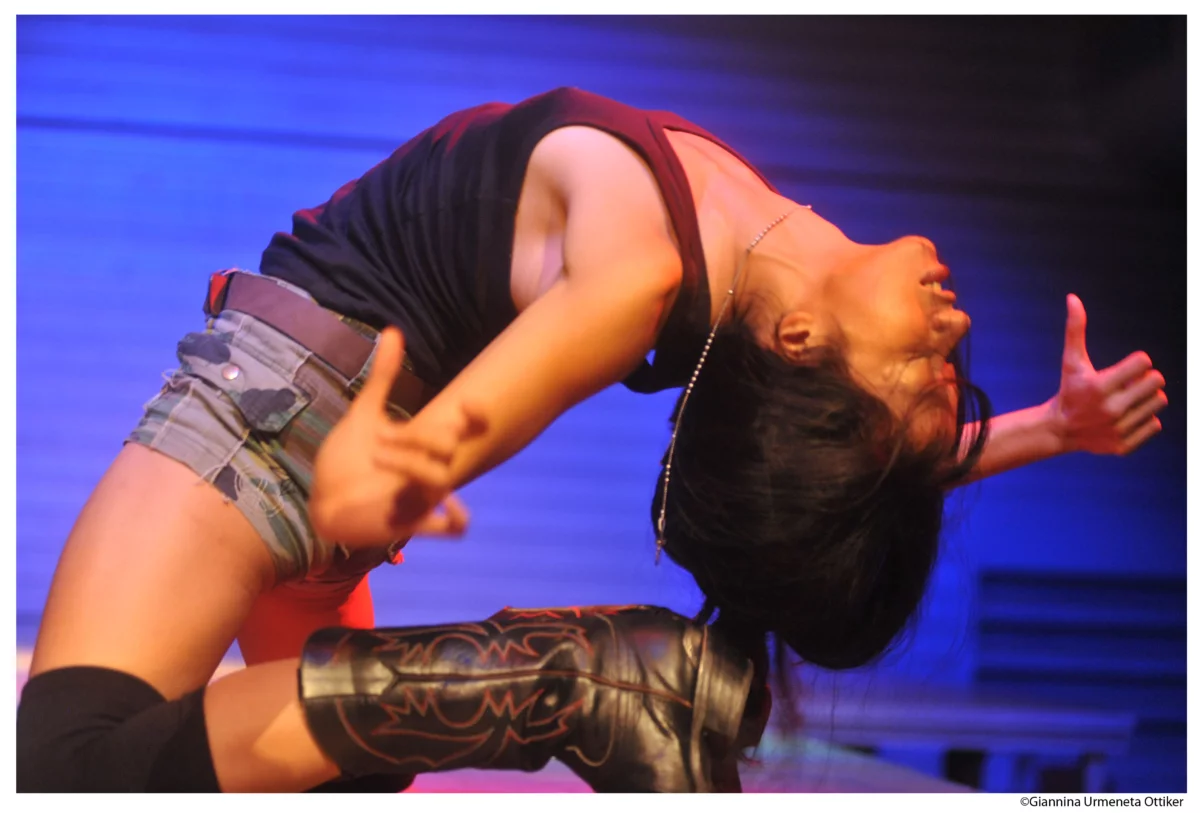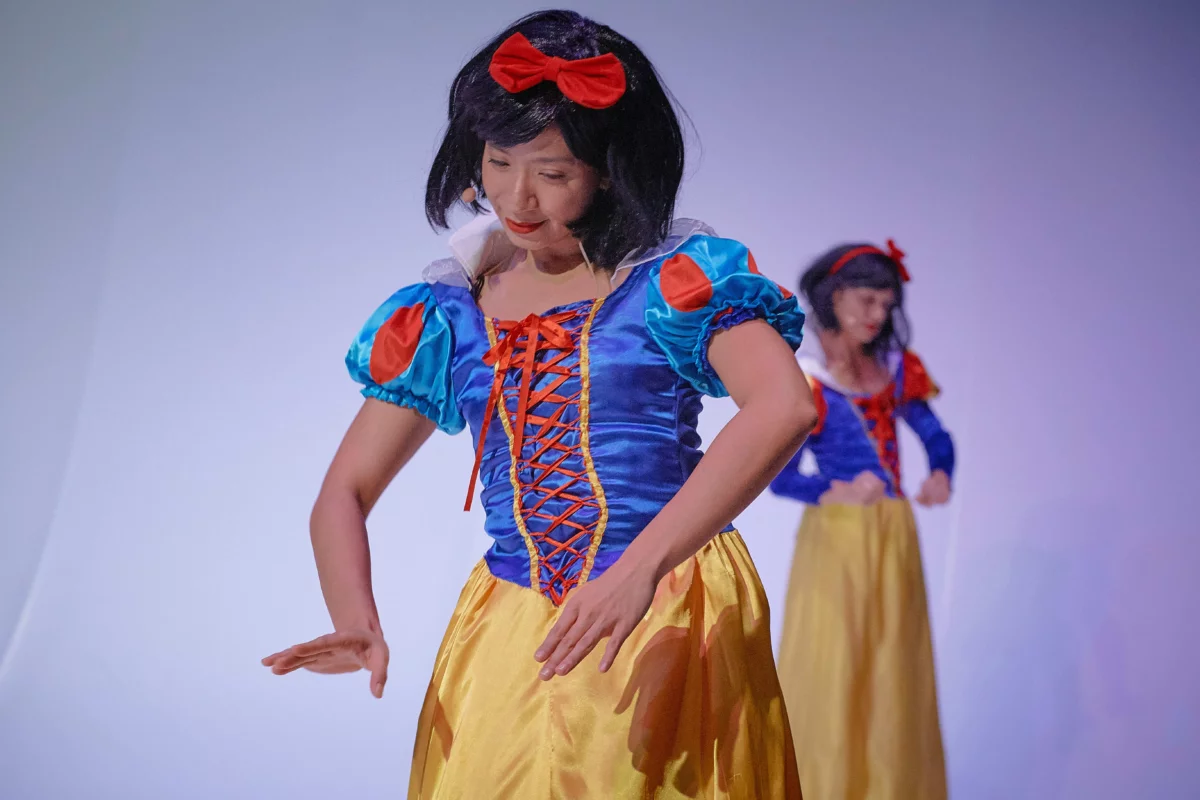"I read everything the Internet has to offer"
By Christine Wahl
In her works, Filipino choreographer Eisa Jocson takes a blunt look at body images, clichés and their effects. For this she receives the Tabori Award International 2023. Cultural journalist Christine Wahl talks to the exceptional artist.
 © Giannina Otter / Workspacebrussels
© Giannina Otter / Workspacebrussels
Eisa Jocson, you started your career as a dancer and choreographer with the invention of an extremely original format of your own: you linked pole dancing – which people mainly associate with nightclubs – with political activism and climbed traffic lights or flagpoles as part of "guerrilla pole dance performances" at public intersections in the Philippines, where you were born. How did this spectacular career start?
Eisa Jocson: Yes, that's right, it's a pretty unusual career start – which is related to the fact that I have deep roots in the pole dance community in the Philippines. I was among the first to ever learn this dance technique there: My aunt, to whom I am very close, encouraged me to take a class, which she also paid for, and a short time later I was teaching pole dancing myself, and was even appointed deputy artistic director of the Philippine Pole Dance Academy.
The dance technique is interesting because so many things overlap in it: On the one hand, it is anchored in acrobatics and the circus, and on the other hand, people associate it primarily with striptease bars. But because pole dancing is also an incredibly demanding and highly effective physical workout, it has becoming increasingly popular as a fitness workout in recent years, even in (Western) European countries, and has found its way into high-end gyms. Is it this complexity, this bundling of so many connotations, that attracts you as an artist to pole dancing?
Jocson: The transition from the nightclub milieu to the fitness industry is actually the point that interests me, because there are various kinds of transformations associated with it. Actually, pole dancing was – as you say –associated with the red-light district and therefore had a stigma attached to it: As a “proper” young woman, you didn’t practice this dance technique. Classic middle-class female college students like me had absolutely no connection with this world until then. Accordingly, most of the participants in the first pole dancing class in the Philippines were also mature women in their 30s, 40s, or 50s who were firmly established in life and didn’t care about these kinds of connotations. Incidentally, the communal experience with these women was very formative for me; it had a lasting influence on my work practice.
What exactly did this arrival of pole dancing in gyms mean in sociopolitical terms?
Jocson: It was accompanied by a radical change in its socioeconomic function: In the red-light district, women danced for the male gaze and were also paid for it by men. In the gym, on the other hand, women now pay to learn and practice pole dancing for themselves, in a predominantly female community and environment. It retains the same movement elements, and even the same skimpy outfits – but the socioeconomic function has radically shifted.
And so too has the symbolic meaning and social image of pole dancing.
Jocson: Exactly. The line between the red-light district and the gym has become more permeable in a concrete sense: Strippers have “ascended” to dance instructors and achieved a real celebrity status within the pole dancing community. Middle-class female students thus suddenly began to look up to star strippers.
In sociology, one would speak of upward mobility. Together with the other aspect – the female self-appropriation of pole dancing – we can therefore observe a double emancipation: first in a classist sense, and second in a feminist sense.
Jocson: My own first choreographic work then consisted of taking this transformation of pole dancing one step further. After it had already penetrated from the closed space of the red-light district into the semi-public space of the gym, I wanted to transfer it completely into the public space.
Which brings us back to the starting point of our conversation: Your guerrilla performances at traffic lights, street lights and railings at street intersections, which you also combined with graffiti tagging.
Jocson: A very masculine practice, exactly! My approach was to mark and reoccupy vertical urban architecture – traffic lights, traffic signs, flagpoles – as a disciplinary architecture of control: This architecture, after all, defines how one has to move, where one has to stop or when one is allowed to leave, whereby at the same time the flagpole in particular still assigns one a national identity.
This shift in meaning and eventual reoccupation of traditional spaces, images, and practices is generally very present in your work. In Macho Dancer, for example, you adapt an erotic style of dance usually performed in Manila nightclubs by young men for a paying audience. Would you agree that the central theme of your work lies in these kinds of transformational practices?
Jocson: I think you could say that – if you consider displacement also in terms of friction. In Macho Dancer, on the one hand, as a woman, I am adopting a male movement vocabulary. On the other hand, as a privileged middle-class person, I am also adopting the body language of a person from a more disadvantaged social background. That's one such moment of friction.
 © Anja Beutler
© Anja Beutler
Snowwhite from Eisa Jocsons' "Princess"
Another form of friction arises in your work Princess, which takes the iconic character of Snow White from the Walt Disney empire as its point of departure: a character who can be found in amusement parks across the world. This performance is also sociologically motivated by Disneyland Hong Kong, one of the largest employers of Filipino dancers, which, however, casts them exclusively in the nameless supporting roles due to their skin color. You give this Disney Snow White character several productive twists and turns in a duet with performance artist Russ Ligtas.
Jocson: There are several frictions here as well – such as the casting of a white archetype by a brown body, or the hijacking of a female body by a male one. But the duet also points to a second important point, which is the subversive power of the copy.
Subversive because every imitation, every – if you will – re-enactment, structurally contains the possibility of change?
Jocson: Exactly. The strategy of copying always includes the practice of deconstruction. Especially when the original, as is the case with Disney's Snow White, has become so strongly entrenched in people's collective consciousness, excellent use can then be made of the copy to attack and blow up the original, as it were, from within. I think that even describes a general cultural practice. As children in the Philippines, for example, we grew up with Disney, but have always, I think, turned those images into something else for ourselves. It’s similar to the way many Filipino bands make a living covering American songs because they are just as good as American bands, but much cheaper.
You lead a real jetset life: With your performances you regularly tour renowned festivals in Asia and Europe, and at the same time you still live in the Philippines, not far from the capital Manila. How does being permanently on the road suit you?
Jocson: So far, living between the Philippines and abroad has worked out very well for me. I think it's a normal way of being in the performing arts: In a way, you just have to go where you have the best opportunities. I'm very happy that my network is really international. In the Philippines, there is no performing arts infrastructure – at least not for the ones I practice. At the same time, the subjects I deal with are really strongly influenced by my Filipino background. Migration is a central theme for me: After all, a large part of the Filipino population works overseas because most of us are forced to earn our living elsewhere.
Also, from this political, social, and sociological aspect, the preoccupation with your country is central to your artistic work. How do you actually develop your performances, what does your research process look like?
Jocson: Ich nehme mir sehr viel Zeit. Die Vorbereitung eines neuen Abends dauert ein bis zwei Jahre – abgesehen davon, dass ich meinen Körper trainiere und in einen neuen Kontext eintauche. Außerdem lese ich sehr viel.
What do you read specifically?
Jocson: Everything that the Internet has to offer. The Internet is really amazing!
But it's also amazing that your work is highly entertaining, despite its fundamentally profound themes and immense complexity. How important is the entertainment factor to you as an artist?
Jocson: I'm a big fan of the friction between the themes and the artistic means. Somehow the absurd is in the nature of things, and I think it's also exactly what creates the complexity you're talking about in the first place. That's why I also adapt the language of the entertainment industry in my work.
Finally, let's look back at the very first steps of your artistic journey: You studied at the Philippine College of the Arts in Manila....
Jocson: ...where a professor took me aside just before I graduated and gave me some very interesting advice.
What kind of advice?
Jocson: He asked me what I planned to do after college, and I told him the same thing my male classmates told him: Painting, performing, exhibiting – the usual stuff. Then he looked at me and said, "You know, the female artists I know who are successful in their profession are all married to rich men."
Oh.
Jocson: I think he was actually giving me that advice with the very best of intentions, he is just a product of his time.
Now, however, you've won the International Tabori Award – and in doing so you've once again successfully earned your own living, in this case specifically, the prize money of 15,000 euros. What does the award mean to you?
Jocson: At first, I was surprised because I didn't even know about the prize and the award, and I thought the e-mail was a fake. Then I did some research – and was very pleased. It really is a timely award because it gives me the confirmation that I should continue.